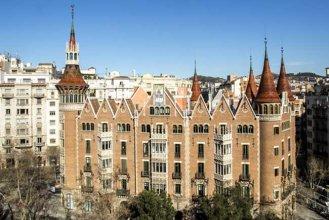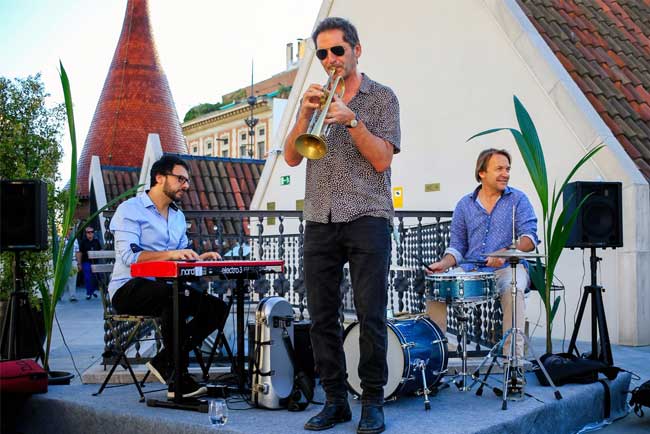Online bookings
24 hours a day
0044 (0) 20 3239 1595
English Phone
Mon-Fri: 8-16:00 GMT
Customer Service
The Casa de les Punxes, or the Casa Terrades as it is also known, is a building that was designed by the modernist architect Josep Puig i Cadafalch, is situated on the Avinguda Diagonal in Barcelona and which you can visit, having purchased your entry tickets online. In 1975, it was declared a Historic National Monument and has now been reorganized to host cultural events that revolve around music and a famous Catalan legend.

Casa de les Punxes literally means "the house of points" and was built in 1905, commissioned by the Terrades sisters who wanted to join three properties together. In order to satisfy this requirement, the architect, Josep Puig i Cadafalch, designed a building with an almost medieval aspect with elements that call to mind the European-Gothic style. One of the most noticeable features of the building are its six towers which are crowned with conical shaped points which are the famous "points" that appear in the building's name. The building is full of symbolism, especially that which is linked to the legend of Sant Jordi: all you will need to remember is to think about the castle in which the princess was imprisoned and from whence the Knight Jordi, saved her from the dragon's claws.
A visit to the Casa de les Punxes revolves around the legend of St. George and the dragon. Thanks to a fun, interactive and immersive experience, visitors can connect with a distant story which mixes magic and history and is known throughout Europe with subtly different nuances. When visiting the Casa de les Punxes you will discover what the three legends that are particularly well known in Catalonia, England and Italy have in common: for example, why did St. George become the patron saint of Catalonia?
The Catalan legend relates that in ancient times, a voracious dragon terrorized his potential new victims who lived in the town of Montblanc, which is close to Barcelona. Terrified and exhausted by the massacres perpetrated by the dragon, the townspeople decided to appease his anger by entering into a pact with the dragon that would enable them to control the number of deaths: they decided that they would sacrifice one person per day and this would be done by drawing lots. After a few days, the misfortune of being chosen fell to the town's princess who was much esteemed and loved by all. As the princess was in the process of fulfilling her destiny, a Knight called Jordi (George in English) came to her rescue: he took on the dragon with his sword and eventually managed to free the princess and the rest of the townspeople. The legend also states that a rose garden sprouted from where the dragon's blood had fallen with the reddest roses ever seen. Jordi then picked a rose and offered it as a gift to the princess and this explains why, on the 23rd April which is the feast day of Sant Jordi, it is traditional in Catalonia for the men to give roses to their other half and that this corresponds to a book as this date also then coincided with International Book Day. Other versions of the legend, such as the Italian version, see the dragon as a pagan symbol of evil: St. George, having metaphorically overcome the evil by killing it, was able to convert the people to Christianity. The British, in fact, recall that the knight who killed the dragon was involved in the famous (as well as bloody) wars of the Crusades.
A visit to the Casa de les Punxes revolves emphatically around the legend of St. George and the dragon. Thanks to a fun, interactive and immersive experience, visitors can reach out and touch the distant past which combines an aura of magic and history and which is known throughout Europe, albeit with slightly different variations. Visiting the Casa de les Punxes makes it possible to discover the common threads which link the three legends which are particularly well known in Catalonia, England and Italy: for example, why did St. George become the patron saint of Catalonia?
The possibility of being able to visit the Casa de les Punxes is relatively recent: its doors opened for the first time in the summer of 2016 and now it is possible to gain access daily throughout the year with the exception of the 25th December, from 09:00 to 20:00 (the last entry is at 19:00). If you would like to book your visit, you can buy your tickets online at: Entry tickets to the Casa de les Punxes.
The Casa de les Punxes is situated in the l'Eixample district, at No. 420 on the Avenida Diagonal. To get there, you would need to get off at the Metro station called Diagonal on the Green Line L3 or the Blue Line L5. You can also reach it from the Verdaguer station (the Yellow Line L4 or Blue L5).
One of the most beautiful areas of the building is undoubtedly the terrace which is dedicated to the designer and the other artists who collaborated in the realization of the building and its decor. There are often concerts and other activities organized here and you can check out the latest updates on what's on by looking at the building's Twitter account: @casadelespunxes.

Born in Mataró in 1867, Josep Puig i Cadafalch was one of the leading Catalan architects at the forefront of design in the 19th and 20th centuries. He belonged to the second generation of modernist architects and achieved a perfect synthesis between his three passions: architecture, politics and history. He was a great promoter of Catalan culture and was representative of the spirit of Catalonia's Renaissance which was stimulated by a powerful bourgeois environment that was able to breathe new life into the novel artistic and cultural paradigm of Modernism in Barcelona. As a modernist architect, he distinguished himself by his ability to blend different architectural and structural elements of Catalan architecture with the influences of central/northern Europe.
If you are interested in seeing other buildings from the Catalan Modernist era in Barcelona, you should read the articles about the works of Antoni Gaudí: Casa Batlló, Casa Milà, Casa Vicens, Palau Güell. On this page, you can request a Guided tours with a Local who can accompany you on a tour of the exteriors of these buildings or a guide to Barcelona for a comprehensive visit to the museums, attractions and monuments in the city.
My comments